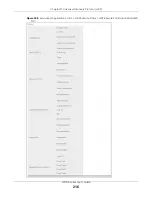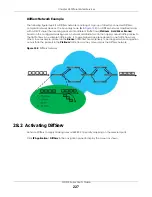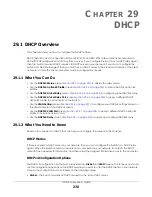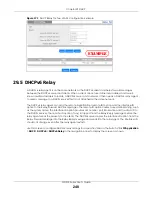
GS1915 Series User’s Guide
230
C
HAPTER
29
DHCP
29.1 DHCP Overview
This chapter shows you how to configure the DHCP feature.
DHCP (Dynamic Host Configuration Protocol RFC 2131 and RFC 2132) allows individual computers to
obtain TCP/IP configuration at start-up from a server. If you configure the Switch as a DHCP relay agent,
then the Switch forwards DHCP requests to DHCP server on your network. If you do not configure the
Switch as a DHCP relay agent then you must have a DHCP server in the broadcast domain of the client
computers or else the client computers must be configured manually.
29.1.1 What You Can Do
• Use the
DHCPv4 Status
screen (
) to display the relay mode.
• Use the
DHCPv4 Option 82 Profile
screen (
) to create DHCPv4 option 82
profiles.
• Use the
DHCPv4 Global Relay
) to configure global DHCPv4 relay.
• Use the
DHCPv4 Global Relay Port
screen (
) to apply a different DHCP
option 82 profile to certain ports on the Switch.
• Use the
VLAN Setting
screen (
) to configure your DHCPv4 settings based on
the VLAN domain of the DHCPv4 clients.
• Use the
DHCPv4 VLAN Port
screen (
) to apply a different DHCP option 82
profile to certain ports in a VLAN.
• Use the
DHCPv6 Relay
screen (
) to enable and configure DHCPv6 relay.
29.1.2 What You Need to Know
Read on for concepts on DHCP that can help you configure the screens in this chapter.
DHCP Modes
If there is already a DHCP server on your network, then you can configure the Switch as a DHCP relay
agent. When the Switch receives a request from a computer on your network, it contacts the DHCP
server for the necessary IP information, and then relays the assigned information back to the computer.
DHCPv4 Configuration Options
The DHCPv4 configuration on the Switch is divided into
Global
and
VLAN
screens. The screen you should
use for configuration depends on the DHCP services you want to offer the DHCP clients on your network.
Choose the configuration screen based on the following criteria:
•
Global
–
The Switch forwards all DHCP requests to the same DHCP server.
















































